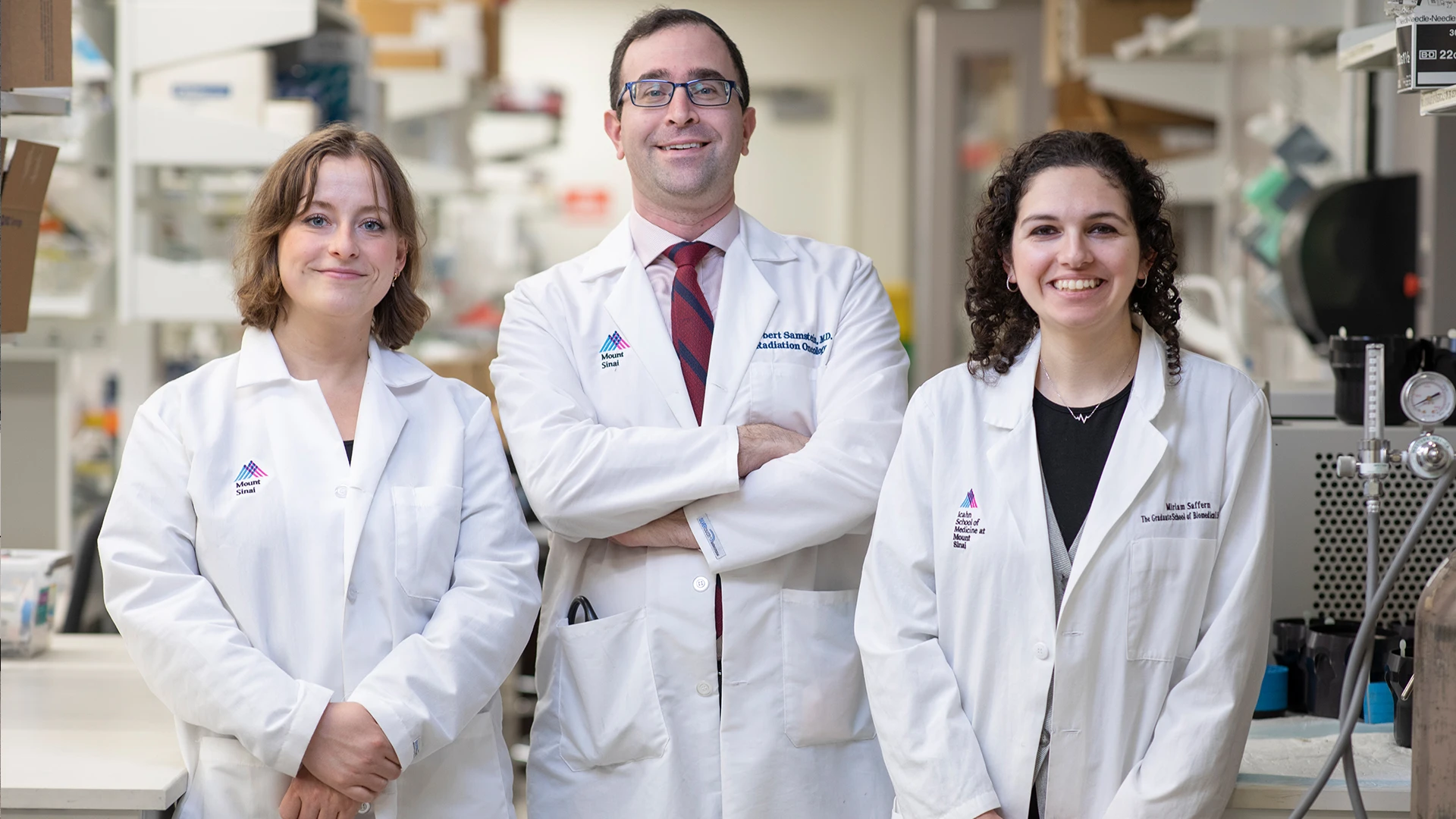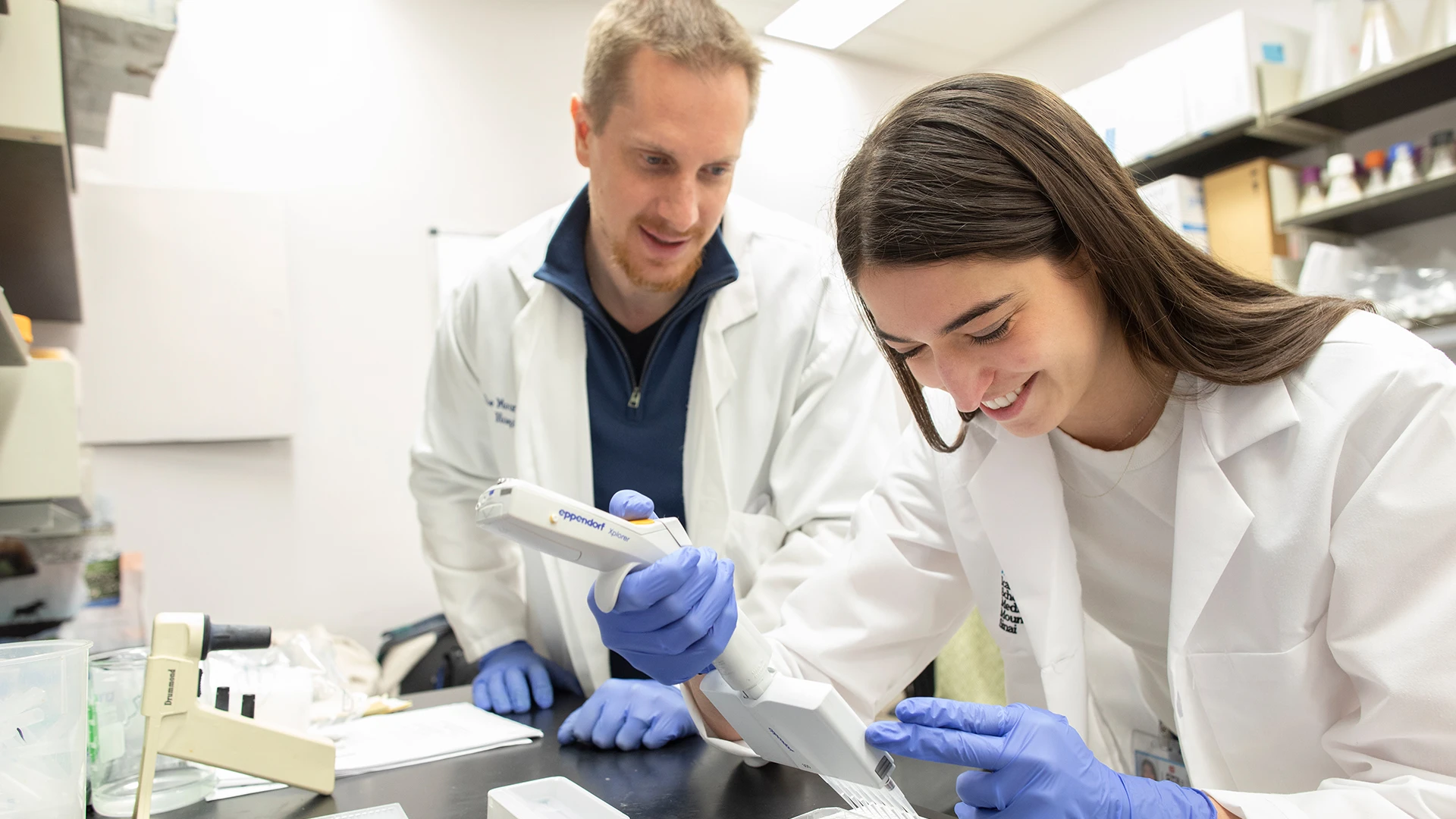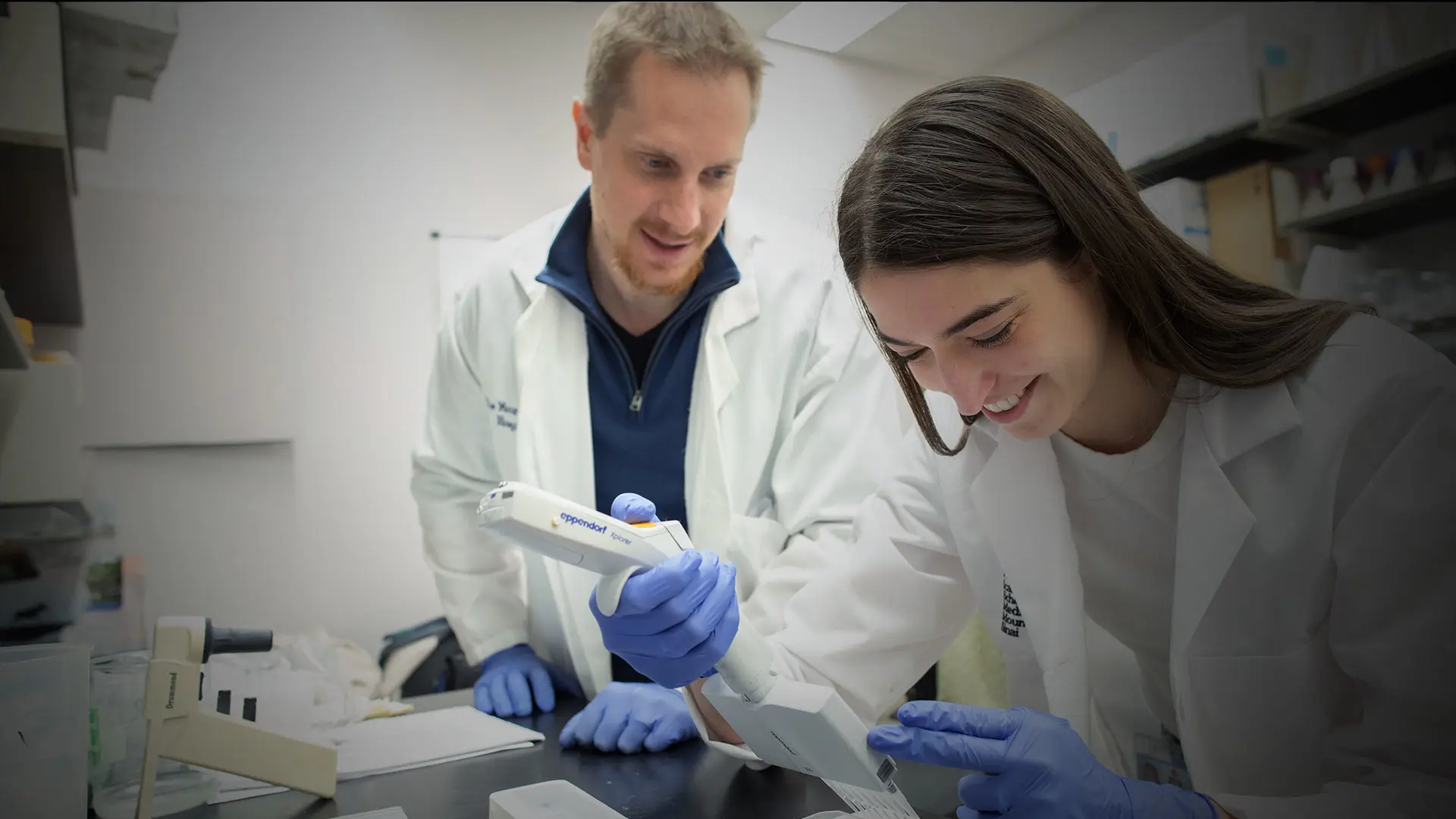A Lab With a Broad Cancer Focus Has Strong Appeal for Two Mount Sinai PhD Students

From left: Natalie Vaninov; Robert (Robbie) Samstein, MD, PhD; and Miriam Saffern
Miriam Saffern, a student at Mount Sinai’s Graduate School of Biomedical Sciences, had her sights set on a lab that could grow her passion for immunology through the lens of data-driven computation and analysis. Natalie Vaninov was also completely sold on immunology, but wanted a lab that could prepare her for a possible career in the biotechnology sector, where she had previously worked.
Both students found their ideal home in the lab of Robert (Robbie) Samstein, MD, PhD, Assistant Professor of Radiation Oncology, and Immunology and Immunotherapy, who became their mentor in the fall of 2019. Particularly inspiring to them was the chance to learn in a scientific environment committed to understanding the mechanisms of multiple cancers, with a goal to translate their findings into therapeutic strategies that could impact patients.
“I really like the patient-centric nature of our work,” says Ms. Saffern, who is on track to graduate in 2025 with a PhD in Biomedical Sciences (Immunology). “As a physician-scientist, Dr. Samstein brings the expertise of a doctor and the in-depth scientific thinking of an immunologist, integrating the two while always emphasizing our primary goal of benefiting patients.”
For Ms. Vaninov, who is also scheduled to graduate in 2025 with a PhD in Biomedical Sciences (Immunology), the allure of the Samstein Lab lay in its pan-cancer focus and its ability to connect students to other labs and research centers at Mount Sinai, such as the Marc and Jennifer Lipschultz Precision Immunology Institute, led by esteemed physician-scientist Miriam Merad, MD, PhD.
The Institute is a scientific hub for all immunological research and immunotechnology centers at the Icahn School of Medicine at Mount Sinai. Dr. Merad, Mount Sinai Professor in Cancer Immunology and Chair of the Department of Immunology and Immunotherapy, is internationally recognized for her work in the fields of dendritic cell and macrophage biology. In addition to these opportunities, Ms. Vaninov and Ms. Saffern were mentored by Diego Chowell, PhD, Assistant Professor of Artificial Intelligence and Human Health, Immunology and Immunotherapy, and Oncological Sciences, whose innovative research efforts are aimed at the intersection of cancer genomics, immunology, and computational biology.
“Having this wide range of mentoring opportunities makes it feel more community-based,” says Ms. Vaninov. “Dr. Merad is a world-class leader in myeloid immunology, and for me that was huge. I was able to attend her lab meetings and get exposure to not just the latest news and developments in the field, but to a classical immunology view of myeloid cells and all the research opportunities it affords.”
Dr. Samstein’s lab, for its part, is heavily focused on exploring the interaction between the immune system and cancer cells, and how that critical pathway can alter the tumor’s ability to be recognized and attacked by the immune system.
“Analyzing large-scale data from biobanks for this project greatly enhanced my computational skills, and evaluating our findings taught me how to think about scientific ideas in new ways, which I will carry with me throughout my career. ”
— Biomedical Sciences PhD student Miriam Saffern
That dynamic took center stage in a paradigm-shifting study reported in February 2024 in Science: An immunogenetic basis for lung cancer risk, that described how human leukocyte antigens (HLAs) present foreign antigens on the cell surface and thus assist the immune system in identifying and eliminating threats, such as malignancies and pathogens.
The study was led by researchers at the Icahn School of Medicine at Mount Sinai in collaboration with the University of Helsinki, Massachusetts General Hospital, and the Broad Institute of MIT and Harvard. Dr. Chowell and Dr. Samstein were co-senior authors of the study, which included Eric Wilson, PhD, co-first author and a postdoctoral fellow in the Chowell Lab, and Dr. Merad, Ms. Vaninov, and Ms. Saffern.
The researchers started with the novel theory that HLA polymorphisms can actually reduce the risk of lung cancer by presenting to the immune system a more diverse antigenic peptide repertoire, resulting in superior immune system control of cancer cells.
"Our findings challenge conventional thinking by demonstrating that immune genetics, specifically HLA-II heterozygosity, plays a significant role in lung cancer risk, especially among smokers," says Dr. Chowell.
“This was an important study for my lab and for the field overall because it showed how we can move forward with not just immunotherapy for some patients, but how we can tweak the immune system to actually prevent cancer from occurring,” says Dr. Samstein. “It shifted the focus on my group’s work.”
It also left an imprint on Ms. Saffern. “Analyzing large-scale data from biobanks for this project greatly enhanced my computational skills, and evaluating our findings taught me how to think about scientific ideas in new ways, which I will carry with me throughout my career,” she says.
Biomedical Sciences PhD student Natalie Vaninov strengthened her basic knowledge and skills in transcriptomics, including RNA sequencing, single-cell analysis, and creating mouse models and then characterizing them with flow cytometry.
For Ms. Vaninov, whose prior experience was with a small biotechnology start-up, the lung cancer risk study strengthened her basic knowledge and skills in transcriptomics, including RNA sequencing, single-cell analysis, and creating mouse models and then characterizing them with flow cytometry. It also gave her the chance to branch out from her primary field of breast cancer into lung cancer research.
Beyond the rigors of the science, the fifth-year graduate students have thrived on the spirit of camaraderie that pervades the lab—a special openness and desire to help others. “We all genuinely care about each other and know we can always count on one another for support and encouragement, both within and outside the lab,” says Ms. Saffern.
How a Mentor in Molecular Pharmacology and Structural Biology Is Providing Extraordinary Research Opportunities for Graduate Students

Daniel Wacker, PhD, with Alexandra (Ally) Parpounas, MSBS
The lessons took hold quickly for Gregory Zilberg, PhD, who would spend five-and-a-half years in the Daniel Wacker, PhD, Lab as a PhD student in Neuroscience. He had read about Dr. Wacker’s work and was eager to study in a lab steeped in the molecular side of neuroscience.
From the start, Dr. Zilberg knew he had found the right academic environment, saying that he was already familiar with Dr. Wacker’s research into the mechanisms by which psychedelic drugs such as LSD bind to serotonin receptors to produce potential therapeutic effects.
“I wanted to observe at a close-up, atomic level the structure of proteins, and how drugs change their overall structure to cause either therapeutic or detrimental effects,” says Dr. Zilberg, who graduated from the PhD program in 2024 and accepted a postdoctoral position at Yale School of Medicine in pharmacology.
Dr. Wacker is an Associate Professor of Pharmacological Sciences, and Neuroscience, at the Icahn School of Medicine at Mount Sinai. His lab is mainly interested in the molecular basis of serotonin signaling and neurotransmitter transport with a goal to understand the mechanics of these processes using a variety of structural, biophysical, and pharmacological methods. Long term, his lab wants to use such insights to develop novel compounds against these drug targets using structure-based drug design.
“I wanted to observe at a close-up, atomic level the structure of proteins, and how drugs change their overall structure to cause either therapeutic or detrimental effects.”
— Gregory Zilberg, PhD
Dr. Zilberg says that working on five research papers during his time with Dr. Wacker gave him the chance to explore the molecular side of how drugs interact with their targets, and how receptors trigger the signaling cascade that eventually changes behavior in not just animal models, but humans.
“Daniel was very knowledgeable about molecular pharmacology and structural biology and pointed me to the right resources for my research, including cryogenic electronic microscopy and X-ray crystallography,” he says. “We had many good scientific conversations during my time in his lab.”
That influence is evident in the arc of Dr. Zilberg’s research, where the focus has been on the structural and pharmacological characterization of serotonin receptor signaling complexes. More broadly, he has meticulously explored synaptic signaling transduction complexes at both structural and atomic levels, with an eye toward therapeutic drug design and further describing how aberrant functioning of these complexes fuels neuropsychiatric disorders.
With her mind set on acquiring basic research and drug discovery skills as a pathway to becoming a clinical psychiatrist, Alexandra (Ally) Parpounas also proved to be a perfect fit for the Wacker Lab.
“He steered me toward thinking about psychiatric drugs in a different way, with a new appreciation for things, such as how a side effect can be mediated through a single receptor, or why a patient shouldn’t be given a particular drug based on their background and medical history,” says Ms. Parpounas, reflecting on her three years in Dr. Wacker’s lab, two years as part of the Master of Science in Biomedical Science (MSBS) program with Dr. Wacker as her preceptor.
Today, Ms. Parpounas, MSBS, is a medical student at the Icahn School of Medicine. “I liked the opportunity to learn basic pharmacology at a rapid rate while working toward the larger goal of deciphering the structure of proteins and how drugs work at the molecular scale.”
The experience also proved enlightening for her mentor. “She was more than just peripherally focused on psychiatric drugs, and that was motivation I had never seen before in a master’s student, many of whom are typically still trying to figure things out,” says Dr. Wacker of Ms. Parpounas. “She was already quite mature at this stage and went on to do some amazing research that was published.”
Together with PhD student Audrey Warren, Dr. Zilberg and Ms. Parpounas co-authored a major study with Dr. Wacker that was published in Science Advances in April 2024, describing Structural insights into the unexpected agonism of tetracyclic antidepressants at serotonin receptors 5-HT1eR and 5-HT1FR. Marta Filizola, PhD, Dean of Mount Sinai’s Graduate School of Biomedical Science, was among the authors and mentors. Dr. Warren received her PhD in 2024 and is now a postdoctoral fellow at Columbia University.
With her mind set on acquiring basic research and drug discovery skills as a pathway to becoming a clinical psychiatrist, Alexandra (Ally) Parpounas also proved to be a perfect fit for the Wacker Lab.
Dr. Warren additionally was first author on a provocative study published in Nature in May 2024, which reported that certain psychedelic drugs interact with an underappreciated member of the serotonin receptor family in the brain known as 5-HT1A to produce therapeutic benefits in animal models.
“Psychedelics such as LSD and psilocybin have entered clinical trials with promising early results, though we still don’t understand how they engage different molecular targets in the brain to trigger their therapeutic effects,” says Dr. Warren, whose co-authors also included Dr. Zilberg and senior author Dr. Wacker. “Our study highlights, for the first time, how serotonin receptors such as 5-HT1A likely modulate the subjective effects of the psychedelic experience and also play a potentially pivotal role in their clinically observed therapeutic outcome.” In a follow-up study published in Science Advances in August 2025, Dr. Warren further showed how 5-HT1A engages distinct pathways, which may provide useful in generating next-generation mental health drugs.
In 2024, the three graduate students also co-authored a paper in Nature Communications on the molecular basis of human trace amine-associated receptor 1 (hTAAR1, hTA1) activation, describing its unique structure.
As a key regulator of monoaminergic neurotransmission and the actions of psychostimulants, hTA1 has been highlighted as a potential target for treating disorders of dopaminergic dysfunction, such as schizophrenia and methamphetamine use disorder, as well as metabolic disorders, cognitive impairment, and sleep-related dysfunction.
The students had work published in Science Advances, Nature, and Nature Communications.
In addition to steady guidance from Dr. Wacker, Ms. Parpounas says she benefited from ongoing training and counsel from lab colleagues Dr. Zilberg and Dr. Warren, especially in the early stages of her work. “As a master’s student,” she recalls, “it was great having all three of them to bounce ideas off of and ask basic questions, such as 'How do I prepare this compound for my experiment?'"
Which is precisely the kind of free-flowing exchange Dr. Wacker strives to promote among his students. “One thing I’ve learned is to not get too much in their way, but to step back after the initial interpretation of data, showing them what things mean, and giving them room to develop on their own and become independent researchers,” he says. “I believe people with great potential will figure things out for themselves.”
